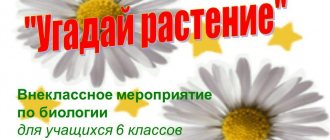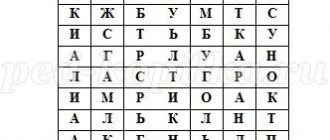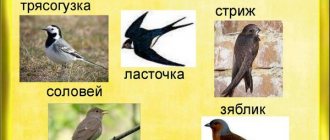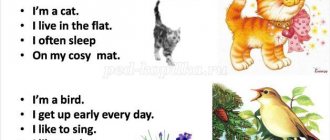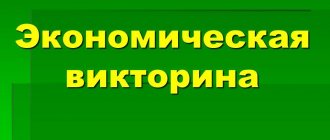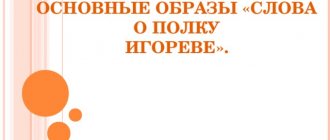Biology Quiz for (8-9 grades with answers)
7. Scientists have long assumed the existence of a connection between the brain and mental activity. But they could not answer the questions about what laws the human brain operates in, what underlies mental activity. The answer to this question was the discovery by physiologist I.M. Sechenov of the reflex basis of the brain. Choose a scientist who scientifically proved the correctness of I.M. Sechenov’s thoughts in his teaching:
A) I.P. Pavlov;
B) N.I. Pirogov;
B) K.I. Shchepin;
D) I.I. Mechnikov.
Correct answer:
A) I.P. Pavlov. It was he who experimentally proved that the basis of higher nervous activity is conditioned reflexes. Many years of work by Pavlov and his students established the most important laws of higher nervous activity.
8. The tone of the human voice largely depends on the condition of the vocal cords. The vocal cords are very elastic, they can only be compared with the best and strongest violin strings. The vocal cords of men and women are different. For men they are:
A) shorter and thinner than women;
B) shorter and thicker than women;
C) longer and thicker than women’s;
D) longer and thinner than women's.
Correct answer: B) longer and thicker than women's. Women's vocal cords are shorter and thinner than men's, which is why their voice is always higher.
9. Currently, about 80 vitamins are known. In most cases, these are various organic substances. Lack of vitamins leads to various disorders in the body. Which of the following vitamins is involved in the metabolism of proteins, carbohydrates, mineral salts and its deficiency causes “night blindness” - a disease in which a person loses the ability to see in the dark?
A) Vitamin A;
B) Vitamin B2;
B) Vitamin C;
D) Vitamin D.
Correct answer: A) Vitamin A. It is with a lack of vitamin A that this disease manifests itself. The daily dose of vitamin A is 900 mcg for adults, 400-1000 mcg for children.
10. Our heart is constantly at work. What is the secret of his tirelessness? This is largely due to the peculiarities of the heart. Three phases can be distinguished in one cardiac cycle. What happens to the heart during the second phase?
A) Both the atria and ventricles contract;
B) The atria contract, the ventricles relax;
B) Both the atria and ventricles are relaxed;
D) The atria are relaxed and the ventricles are contracting.
Correct answer: D) The atria are relaxed, the ventricles are contracting. And during the first phase, the atria contract, the ventricles are relaxed, and in the third phase, a general relaxation of the heart occurs.
9th grade
11. During the Mesozoic era, the dominant plants were conifers, gymnosperms, and cycads; in the end, many died out, and they were replaced by willows, palm trees, and oaks. In the animal world there was the dawn of dinosaurs, reptiles, reptiles, mammals, insects, and at the end of the era birds and placental mammals appeared. The Mesozoic era was divided into 3 periods.
Biology quiz for grades 8-9
Biology Quiz.
8th grade – 9th grade
1. Previously, in case of cardiac arrest, a person was considered unconditionally dead, but today he can be saved for the first time minutes after the arrest by administering a medical drug. What drug should be administered to a person?
A) Insulin; B) Adrenaline; B) Glucagon; D) Diphenhydramine.
Correct answer: b) adrenaline, because it is adrenaline that contributes to a significant increase and acceleration of heart contractions, increasing the automaticity of the heart muscle.
2. Each part of the brain is responsible for certain organs and their functions. A person with a damaged area of the cortex in the temporal lobe of the brain will experience difficulty in
A) Coordination; B) Perception of sound; B) Distinguishing colors; D) Feeling cold.
Correct answer: b) perception of sound, since the auditory zone is located in the temporal lobe of the brain.
3. An organ is a separate part of the body, consisting of several tissues and performing certain functions. According to this definition, an organ is not
A) Hydra tentacle; B) Apple tree petal; B) Human finger; D) Capillary.
Correct answer: d) capillary, because the capillary consists of one type of tissue and is not a separate part of the body, it is only part of the circulatory system.
4. Science is a sphere of human activity aimed at developing and theoretically systematizing objective knowledge about the subject of study. What is the science of mushrooms called?
A) Mycology; B) Botany; B) Ornithology; D) Entomology.
Correct answer: a) mycology - (from the Greek mykes - mushroom and logos - science) the science of mushrooms.
5. Mosquitoes are known to transmit malaria. What mosquitoes carry this disease?
A) Female mosquitoes; B) Male mosquitoes; B) All mosquitoes; D) Mosquitoes up to 3 days old.
Correct answer: c) Female mosquito, because mosquitoes are only a carrier of malaria from a sick person to a healthy person, and only females bite people.
6. Various life support processes constantly occur in the human body. Also, a person perceives all changes occurring in the environment and reacts to them. All these processes are regulated and controlled by the nervous system and glands of the endocrine apparatus. Which gland secretes such an important hormone as growth hormone?
A) Thyroid gland;
B) Pituitary gland;
B) Thymus gland;
D) Pancreas.
Correct answer: B) Pituitary gland. Indeed, growth hormone is secreted by the pituitary gland. In its pure form, growth hormone was isolated only in the 1970s, first from the pituitary gland of a bull, and then from horses and humans.
7. Scientists have long assumed the existence of a connection between the brain and mental activity. But they could not answer the questions about what laws the human brain operates in, what underlies mental activity. The answer to this question was the discovery by physiologist I.M. Sechenov of the reflex basis of the brain. Choose a scientist who scientifically proved the correctness of I.M. Sechenov’s thoughts in his teaching:
A) I.P. Pavlov;
B) N.I. Pirogov;
B) K.I. Shchepin;
D) I.I. Mechnikov.
Correct answer:
A) I.P. Pavlov. It was he who experimentally proved that the basis of higher nervous activity is conditioned reflexes. Many years of work by Pavlov and his students established the most important laws of higher nervous activity.
8. The tone of the human voice largely depends on the condition of the vocal cords. The vocal cords are very elastic, they can only be compared with the best and strongest violin strings. The vocal cords of men and women are different. For men they are:
A) shorter and thinner than women;
B) shorter and thicker than women;
C) longer and thicker than women’s;
D) longer and thinner than women's.
Correct answer: B) longer and thicker than women's. Women's vocal cords are shorter and thinner than men's, which is why their voice is always higher.
9. Currently, about 80 vitamins are known. In most cases, these are various organic substances. Lack of vitamins leads to various disorders in the body. Which of the following vitamins is involved in the metabolism of proteins, carbohydrates, mineral salts and its deficiency causes “night blindness” - a disease in which a person loses the ability to see in the dark?
A) Vitamin A;
B) Vitamin B2;
B) Vitamin C;
D) Vitamin D.
Correct answer: A) Vitamin A. It is with a lack of vitamin A that this disease manifests itself. The daily dose of vitamin A is 900 mcg for adults, 400-1000 mcg for children.
10. Our heart is constantly at work. What is the secret of his tirelessness? This is largely due to the peculiarities of the heart. Three phases can be distinguished in one cardiac cycle. What happens to the heart during the second phase?
A) Both the atria and ventricles contract;
B) The atria contract, the ventricles relax;
B) Both the atria and ventricles are relaxed;
D) The atria are relaxed and the ventricles are contracting.
Correct answer: D) The atria are relaxed, the ventricles are contracting. And during the first phase, the atria contract, the ventricles are relaxed, and in the third phase, a general relaxation of the heart occurs.
9th grade
11. During the Mesozoic era, the dominant plants were conifers, gymnosperms, and cycads; in the end, many died out, and they were replaced by willows, palm trees, and oaks. In the animal world there was the dawn of dinosaurs, reptiles, reptiles, mammals, insects, and at the end of the era birds and placental mammals appeared. The Mesozoic era was divided into 3 periods.
Which of the following periods does not belong to these three?
A) Triassic
B) Jurassic
B) chalk
D) Neogene
Correct answer: Neogene is a geological period, the second period of the Cenozoic.
12. Parapithecus is the oldest fossil ape. Appeared about 35 million years ago. Which of the following is not a Parapithecus?
A) gibbons
B) lower primates
B) orangutans
D) Dryopithecus
Correct answer:
B - lower primates. Parapithecus is a fossilized great ape; ancestors of apes and humans.
13. Inorganic substances are chemical substances that are not organic, that is, they do not contain carbon (except for carbides, cyanides, carbonates, carbon oxides and some other compounds that are traditionally classified as inorganic). Inorganic compounds do not have the carbon skeleton characteristic of organic compounds.
Which of the following applies to inorganic substances?
A) water
B) nitrogen
B) lipids
D) carbohydrates
Correct answer:
A - water, since inorganic compounds do not have the carbon skeleton characteristic of organic ones.
14. Chemotrophs are a group of microorganisms that use the energy contained in chemicals for the purposes of biosynthesis. There are 2 groups: chemolithotrophs and chemoorganotrophs. Which of the following is true of chemotrophs?
A) viruses
B) saprophytes
B) sulfur bacteria
D) yeast
Correct answer: B. Chemosynthesizing bacteria (chemolithoautotrophs) are bacteria that use carbon dioxide as the only carbon source, obtain energy as a result of redox reactions, and inorganic compounds are electron donors.
15. Higher plants are one of two subkingdoms of the plant world. Unites at least 300 thousand species of plants of the following groups: rhinium-shaped, mossy-shaped, psilotoid, lycophyte, horsetail-shaped, ferns, gymnosperms and flowering, or angiosperms, plants. Which of the following does not apply to the reproductive organs of higher plants?
A) flower
B) seeds
B) leaf
D) sporangia
Correct answer: B. Unlike lower plants, higher plants are complexly differentiated multicellular organisms adapted to life in a terrestrial environment (with the exception of a few and clearly secondary aquatic forms), with the correct alternation of two generations: sexual (Gametophyte) and asexual (Sporophyte ).
16. In his experiments, G. Mendel chose for experiments organisms belonging to pure lines, i.e. such plants, in a series of generations of which, during self-pollination, all offspring were uniform in the studied trait. G. Mendel used the following characteristics for this: seed shape, seed color, flower color, flower position, stem length and fruit shape. What plant did G. Mendel use for his experiments?
A) Beans
B) Peas
B) Nightshade
D) Potatoes
Correct answer: B. Peas were not chosen by Mendel by chance. Species Pisum sativum L
. very convenient for studying heredity. Firstly, it is easy to grow and its entire life cycle is quick. Secondly, it is prone to self-pollination, and without self-pollination, as we will see later, Mendel’s experiments would have been impossible.
17. Postembryonic development is divided into two types: direct and indirect (with incomplete transformation and complete). Choose the answer in which the born organism has similarities with the parent forms:
A) Reptiles, birds, mammals
B) Arthropods, coelenterates
B) Insects
D) Viruses
Correct answer:
A. With direct development, the born organism is similar to an adult individual and differs only in size, proportions and underdevelopment of some organs.
18. In cattle, the polled (hornless) gene dominates over the horned gene. What offspring will be produced when crossing a polled homozygous cow with a horned bull?
A) All descendants will be polled;
B) All descendants will have horns;
C) Half of the offspring will be horned, and half will be polled;
D) Two thirds of the offspring will be polled, and the rest will be horned.
Correct answer: A. All descendants will be polled.
1st Mendel's law.
19. In 1900 Goudeau de Vries, K. Correns, Cermak confirmed the laws…. What was the name of the Austrian biologist and botanist who played a huge role in the development of the concept of heredity?
A) Robert Hooke
B) Rudolf Virchow.
B) Matthias Schleiden
D) Gregor Mendel
Correct answer: In 1900, independently of each other, three botanists - K. Correns (Germany), G. de Vries (Holland) and E. Chermak (Austria) discovered in their experiments the patterns previously discovered by Mendel.
20. Who proved the law of embryonic similarity: “embryos exhibit, already from the earliest stages, a certain general similarity within the type”?
A) Ernest Haeckel and Fritz Müller;
B) Karl Baer
B) Robert Hooke
D) Matthias Schleiden and Theodor Schwann.
Correct answer: B-Karl Baer. In 1828, Baer formulated a pattern called Baer's Law
Biology Quiz.
8th grade – 9th grade
1. Previously, in case of cardiac arrest, a person was considered unconditionally dead, but today he can be saved for the first time minutes after the arrest by administering a medical drug. What drug should be administered to a person?
A) Insulin; B) Adrenaline; B) Glucagon; D) Diphenhydramine.
Correct answer: b) adrenaline, because it is adrenaline that contributes to a significant increase and acceleration of heart contractions, increasing the automaticity of the heart muscle.
2. Each part of the brain is responsible for certain organs and their functions. A person with a damaged area of the cortex in the temporal lobe of the brain will experience difficulty in
A) Coordination; B) Perception of sound; B) Distinguishing colors; D) Feeling cold.
Correct answer: b) perception of sound, since the auditory zone is located in the temporal lobe of the brain.
3. An organ is a separate part of the body, consisting of several tissues and performing certain functions. According to this definition, an organ is not
A) Hydra tentacle; B) Apple tree petal; B) Human finger; D) Capillary.
Correct answer: d) capillary, because the capillary consists of one type of tissue and is not a separate part of the body, it is only part of the circulatory system.
4. Science is a sphere of human activity aimed at developing and theoretically systematizing objective knowledge about the subject of study. What is the science of mushrooms called?
A) Mycology; B) Botany; B) Ornithology; D) Entomology.
Correct answer: a) mycology - (from the Greek mykes - mushroom and logos - science) the science of mushrooms.
5. Mosquitoes are known to transmit malaria. What mosquitoes carry this disease?
A) Female mosquitoes; B) Male mosquitoes; B) All mosquitoes; D) Mosquitoes up to 3 days old.
Correct answer: c) Female mosquito, because mosquitoes are only a carrier of malaria from a sick person to a healthy person, and only females bite people.
6. Various life support processes constantly occur in the human body. Also, a person perceives all changes occurring in the environment and reacts to them. All these processes are regulated and controlled by the nervous system and glands of the endocrine apparatus. Which gland secretes such an important hormone as growth hormone?
A) Thyroid gland;
B) Pituitary gland;
B) Thymus gland;
D) Pancreas.
Correct answer: B) Pituitary gland. Indeed, growth hormone is secreted by the pituitary gland. In its pure form, growth hormone was isolated only in the 1970s, first from the pituitary gland of a bull, and then from horses and humans.
7. Scientists have long assumed the existence of a connection between the brain and mental activity. But they could not answer the questions about what laws the human brain operates in, what underlies mental activity. The answer to this question was the discovery by physiologist I.M. Sechenov of the reflex basis of the brain. Choose a scientist who scientifically proved the correctness of I.M. Sechenov’s thoughts in his teaching:
A) I.P. Pavlov;
B) N.I. Pirogov;
B) K.I. Shchepin;
D) I.I. Mechnikov.
Correct answer:
A) I.P. Pavlov. It was he who experimentally proved that the basis of higher nervous activity is conditioned reflexes. Many years of work by Pavlov and his students established the most important laws of higher nervous activity.
8. The tone of the human voice largely depends on the condition of the vocal cords. The vocal cords are very elastic, they can only be compared with the best and strongest violin strings. The vocal cords of men and women are different. For men they are:
A) shorter and thinner than women;
B) shorter and thicker than women;
C) longer and thicker than women’s;
D) longer and thinner than women's.
Correct answer: B) longer and thicker than women's. Women's vocal cords are shorter and thinner than men's, which is why their voice is always higher.
9. Currently, about 80 vitamins are known. In most cases, these are various organic substances. Lack of vitamins leads to various disorders in the body. Which of the following vitamins is involved in the metabolism of proteins, carbohydrates, mineral salts and its deficiency causes “night blindness” - a disease in which a person loses the ability to see in the dark?
A) Vitamin A;
B) Vitamin B2;
B) Vitamin C;
D) Vitamin D.
Correct answer: A) Vitamin A. It is with a lack of vitamin A that this disease manifests itself. The daily dose of vitamin A is 900 mcg for adults, 400-1000 mcg for children.
10. Our heart is constantly at work. What is the secret of his tirelessness? This is largely due to the peculiarities of the heart. Three phases can be distinguished in one cardiac cycle. What happens to the heart during the second phase?
A) Both the atria and ventricles contract;
B) The atria contract, the ventricles relax;
B) Both the atria and ventricles are relaxed;
D) The atria are relaxed and the ventricles are contracting.
Correct answer: D) The atria are relaxed, the ventricles are contracting. And during the first phase, the atria contract, the ventricles are relaxed, and in the third phase, a general relaxation of the heart occurs.
9th grade
11. During the Mesozoic era, the dominant plants were conifers, gymnosperms, and cycads; in the end, many died out, and they were replaced by willows, palm trees, and oaks. In the animal world there was the dawn of dinosaurs, reptiles, reptiles, mammals, insects, and at the end of the era birds and placental mammals appeared. The Mesozoic era was divided into 3 periods.
Which of the following periods does not belong to these three?
A) Triassic
B) Jurassic
B) chalk
D) Neogene
Correct answer: Neogene is a geological period, the second period of the Cenozoic.
12. Parapithecus is the oldest fossil ape. Appeared about 35 million years ago. Which of the following is not a Parapithecus?
A) gibbons
B) lower primates
B) orangutans
D) Dryopithecus
Correct answer:
B - lower primates. Parapithecus is a fossilized great ape; ancestors of apes and humans.
13. Inorganic substances are chemical substances that are not organic, that is, they do not contain carbon (except for carbides, cyanides, carbonates, carbon oxides and some other compounds that are traditionally classified as inorganic). Inorganic compounds do not have the carbon skeleton characteristic of organic compounds.
Which of the following applies to inorganic substances?
A) water
B) nitrogen
B) lipids
D) carbohydrates
Correct answer:
A - water, since inorganic compounds do not have the carbon skeleton characteristic of organic ones.
14. Chemotrophs are a group of microorganisms that use the energy contained in chemicals for the purposes of biosynthesis. There are 2 groups: chemolithotrophs and chemoorganotrophs. Which of the following is true of chemotrophs?
A) viruses
B) saprophytes
B) sulfur bacteria
D) yeast
Correct answer: B. Chemosynthesizing bacteria (chemolithoautotrophs) are bacteria that use carbon dioxide as the only carbon source, obtain energy as a result of redox reactions, and inorganic compounds are electron donors.
15. Higher plants are one of two subkingdoms of the plant world. Unites at least 300 thousand species of plants of the following groups: rhinium-shaped, mossy-shaped, psilotoid, lycophyte, horsetail-shaped, ferns, gymnosperms and flowering, or angiosperms, plants. Which of the following does not apply to the reproductive organs of higher plants?
A) flower
B) seeds
B) leaf
D) sporangia
Correct answer: B. Unlike lower plants, higher plants are complexly differentiated multicellular organisms adapted to life in a terrestrial environment (with the exception of a few and clearly secondary aquatic forms), with the correct alternation of two generations: sexual (Gametophyte) and asexual (Sporophyte ).
16. In his experiments, G. Mendel chose for experiments organisms belonging to pure lines, i.e. such plants, in a series of generations of which, during self-pollination, all offspring were uniform in the studied trait. G. Mendel used the following characteristics for this: seed shape, seed color, flower color, flower position, stem length and fruit shape. What plant did G. Mendel use for his experiments?
A) Beans
B) Peas
B) Nightshade
D) Potatoes
Correct answer: B. Peas were not chosen by Mendel by chance. Species Pisum sativum L
. very convenient for studying heredity. Firstly, it is easy to grow and its entire life cycle is quick. Secondly, it is prone to self-pollination, and without self-pollination, as we will see later, Mendel’s experiments would have been impossible.
17. Postembryonic development is divided into two types: direct and indirect (with incomplete transformation and complete). Choose the answer in which the born organism has similarities with the parent forms:
A) Reptiles, birds, mammals
B) Arthropods, coelenterates
B) Insects
D) Viruses
Correct answer:
A. With direct development, the born organism is similar to an adult individual and differs only in size, proportions and underdevelopment of some organs.
18. In cattle, the polled (hornless) gene dominates over the horned gene. What offspring will be produced when crossing a polled homozygous cow with a horned bull?
A) All descendants will be polled;
B) All descendants will have horns;
C) Half of the offspring will be horned, and half will be polled;
D) Two thirds of the offspring will be polled, and the rest will be horned.
Correct answer: A. All descendants will be polled.
1st Mendel's law
19. In 1900 Goudeau de Vries, K. Correns, Cermak confirmed the laws…. What was your name
Austrian biologist and botanist, who played a huge role in the development of the concept of heredity?
A) Robert Hooke
B) Rudolf Virchow.
B) Matthias Schleiden
D) Gregor Mendel
Correct answer: In 1900, independently of each other, three botanists - K. Correns (Germany), G. de Vries (Holland) and E. Chermak (Austria) discovered in their experiments the patterns previously discovered by Mendel.
20. Who proved the law of embryonic similarity: “embryos exhibit, already from the earliest stages, a certain general similarity within the type”?
A) Ernest Haeckel and Fritz Müller;
B) Karl Baer
B) Robert Hooke
D) Matthias Schleiden and Theodor Schwann.
Correct answer: B-Karl Baer. In 1828, Baer formulated a pattern called Baer's Law
Biology quiz 9th grade with answers and questions
Quiz for 9th grade students with answers “Live clocks and barometers”
It is known that Carl Linnaeus was the first to create a “flower clock.” Now botanists all over the world can create flower clocks from plants in their area in any corner of the globe. Let's try to create our own watch. Two teams of eight students are invited. Students approach the leader. It has two dials and two sets of cards. One team places the plants shown in the pictures in the order in which they open their flowers during the day, and the second team places the cards in the order in which they close their flowers during the day. At each dial, a consultant checks (every) student's answers. If the answer is incorrect, then the correct answer must be found by team members, fans or another team, only after that the consultant can name the correct answer, then the next participant comes up, and the order of the answer is the same if his answer is incorrect.
Answers for the first team. (Flowers open.) At 3.00 am - salsify. At 4.00 am - rosehip. At 5.00 am - poppy. At 6.00 am - dandelion. At 7.00 am - potatoes, water lily. At 8.00 am - hawk. At 9.00 am - marigolds (calendula). At 10.00 am - norichnik. Answers for the second team. (The flowers are closing.) At 10.00 - chicory.
At 11.00 o'clock - sow thistle. At 13.00 - field carnation. At 14.00 hours - poppy. At 15.00 - marigolds. At 16.00 o'clock - Len. At 17.00 o'clock - hawk. At 18.00 o'clock - sorrel. At 19.00 - rosehip. Quiz “Plants and animals - predictors”
The quiz is conducted in addition to the previous one.
The questions are answered by a representative of the team that finds the answer first; if the answer is incorrect, then the turn moves on to the next team. 1. What houseplant can predict the weather? (Monstera begins to release droplets of moisture a day before bad weather.) 2. Which plants lower their leaves at sunset and open them at sunrise? (Heliotrope, mimosa.) 3. What animals have an internal clock? (Bees, birds.) 4. How do swallows predict the weather? (Before the rain, swallows fly low above the ground, as insects also fly down.) 5. How does a water lily predict rain and tell the time? (It closes its flowers before rain and in the evening.) 6. This weed is nicknamed “barometer”. If he hasn’t opened the flowers before nine in the morning, then expect rain. It is also a favorite food of songbirds. Name this weed. (Woodlouse.) 7. In an aquarium you can have animals that predict the weather. In good weather they lie or swim leisurely, but they scurry restlessly in front of the wind, and before a thunderstorm they stick to the glass and wriggle convulsively. What kind of animals are these? (False horse leeches.) 8. How can lilac, jasmine, dandelion and chestnut predict the weather? (Lilac and jasmine smell strongly, dandelion does not open its flowers, chestnut leaves have sticky juice on their leaves a day before rain.) 9. Where is the biological clock of a cockroach? (Subpharyngeal ganglion.) 10. What marine animal predicts the approach of a storm 10-15 hours in advance? Why? (Jellyfish, it perceives infrasounds with the help of an “ear” - a tiny ball on a stalk in which tiny pebbles float. They rub against the nerve receptors in the walls of the ball, and the jellyfish hears the roar of an approaching storm, so all jellyfish go to the depths.) 11. What are they? Do the animals in the aquarium tell the observer about the high and low tide times in that area? (These are oysters; during high tide they open their valves wide.) 12. What fish can be called living barometers? (The fish rushes around the aquarium. The loach comes to the surface within 24 hours before the rain, the catfish lives at the bottom and emerges before a thunderstorm or bad weather. The bleak fish jumps out of the water after insects before the rain.) 13. Which bird starts the day and announces the cold? (Rooster) 14. How do sparrows predict frost? (Sparrows carry down and feathers under the roofs before frost.) 15. How do you know at sea that there will be calm? (In calm weather, birds fly out early and move far from the coast. This means 6-12 hours of calm.) 16. For what diseases does a person feel an imminent change in the weather? (With rheumatism, osteochondrosis, and blood pressure disorders, a person suffers from pain before bad weather, as atmospheric pressure decreases.) 17. Which part of the brain acts like a thermostat? (This is the hypothalamus; it transmits information to the pituitary gland, which sends an alarm signal to the general gland system.) 18. How have people in Japan learned about an earthquake for a long time? (Small fish in aquariums begin to rush about within a few hours.) 19. Is it possible to determine the air temperature by the chirping of a cricket? (Yes. The number of sounds in fourteen seconds plus forty is equal to the air temperature in Fahrenheit.) Presenter . So, the jury tallies the points, and we will summarize what we have learned. The famous English doctor Edward Jenner described the approach of rain in a very original way. The lights sparkled into the night, the fireflies lit up the ravine, the mercury fell in the barometer, and now the wind begins to blow. It’s as if the distant forest has become closer, It’s as if the vault of heaven has become lower, The clouds are pressed to the ground, And the cricket’s song hurts the ears. She is echoed by the sharp cry of a thrush, The water is clearer than ever, The fish is busy playing - Grabbing flies above the water. A spider peeked out of the web, suddenly pulled me towards the sofa, and my dog stopped gnawing on the callus, waved his tail and went to sleep. Obedient to the wind, the dust of the roads has curled up into a spinning ball. Smoke settles on the slopes of the roofs, The Shepherd is tormented by foreboding. Evil flies are biting the cattle, The swallow is flying lower and lower, The frog has changed color - She is wearing a brown jacket, And the toad crawled out into the grass, The pig is worried in the barn. It’s fresh, even though it’s a June day, Touch it - the old stump is wet, The rooks have descended from the heights, As if struck by a bullet. The Kuroslep closed his eyes, Old Betty’s nerves began to ache, the closet crackled slightly, and there was a smell of the dampness of the ditches. A cat is warming up by the fireplace, rubbing his whiskers with his fluffy paw, the pre-sunset distance is pale, the moon is hiding behind the clouds. Yes, it will rain! It's time to come to terms with the fact that the picnic will not take place...
We recommend watching:
Botany game “What? Where? When?”, 6-8 grades Biology game, 6th grade. Field of Miracles Game travel with indoor plants, grades 5-6 Competition for biology experts, grade 6
Similar articles:
Biology quiz game, 7th grade
Extracurricular activity in biology, 7th grade
Extracurricular activities in 9th grade. Developments
